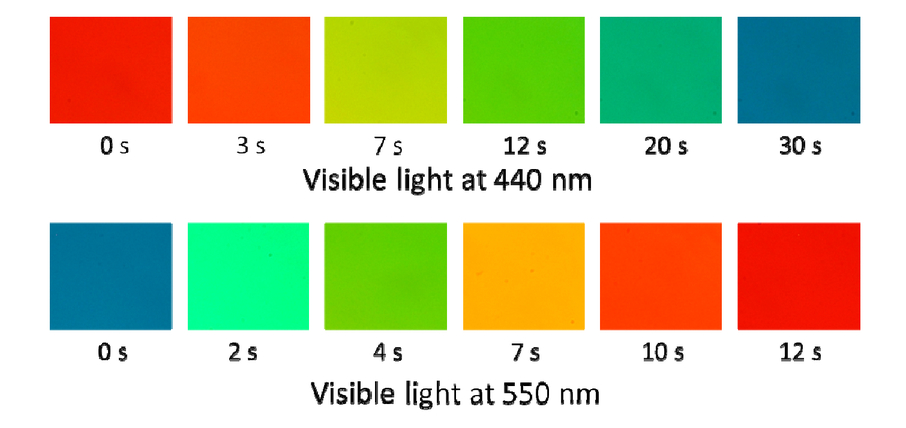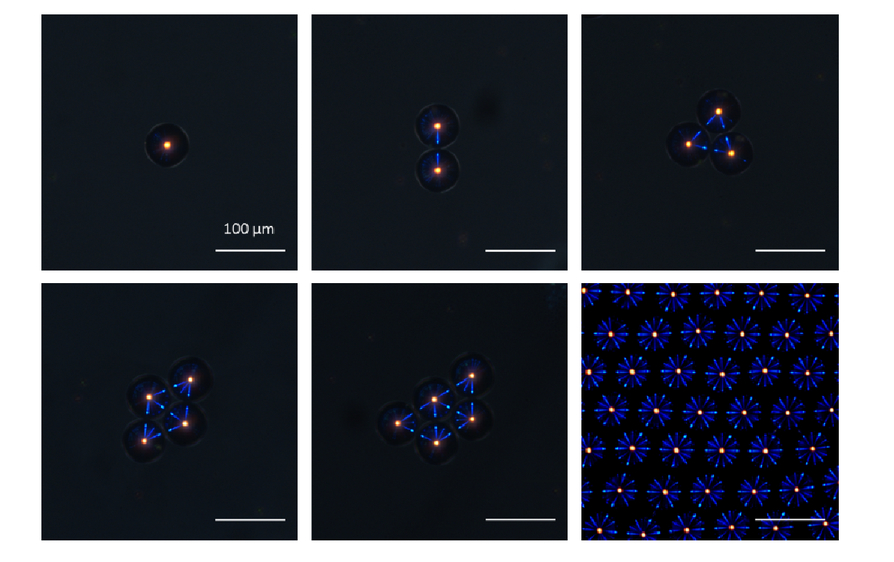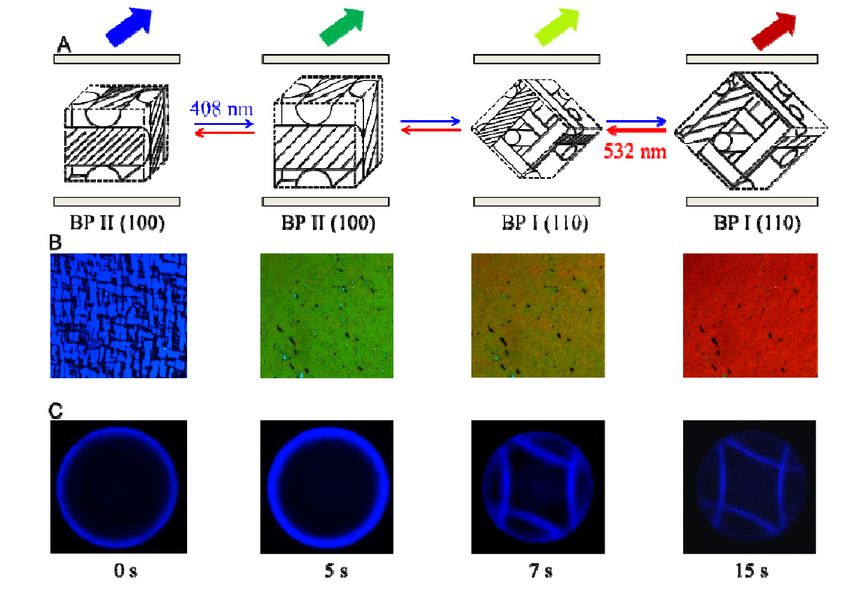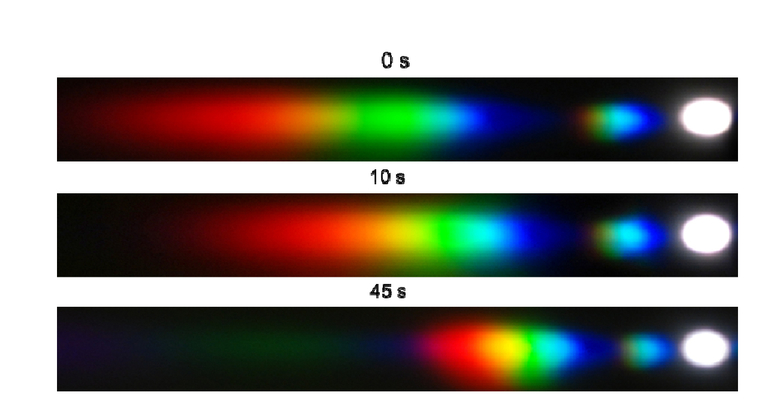|
|
1.IntroductionStimuli-directing self-organized supramolecular architectures with desired properties provide the necessary thrust in the bottom-up nanofabrication of smart molecular materials and devices.1 Among different readily accessible stimuli such as electric and magnetic fields, temperature, pH and chemical reactions, light stimulus possesses fascinating and multiple advantages because of its remote, spatial, and temporal controllability in different environments. Chiral photoisomerizable molecular switches or motors in achiral liquid crystal (LC) hosts capable of self-organizing into phototunable helical superstructures, i.e. photoresponsive cholesteric LCs (CLCs), undoubtedly represent such an elegant functional system.2-11 It should be noted that the cholesteric phase was the first LC phase to be recognized as a different and distinct state of matter. The helical superstructures of CLCs are characterized by both the sign (i.e. handedness) and magnitude of their pitch P (Figure 1). The direction of director rotation about the helix axis defines its handedness, whereas P is the distance along the helix axis over which the director rotation completes a full turn, i.e. 360°. According to Bragg’s law, CLCs selectively reflect circularly polarized light (CPL) with the same handedness as the helix, and the wavelength of the CPL is determined by λ = nP, where n is the average index of refraction of the host nematic LC. When the pitch of CLC is of the order of visible light, the CLC selectively reflects colored light. Consequently, the periodic dielectric helical superstructures of the CLCs have been regarded as self-organized one-dimensional (1D) photonic band gap (PGB) materials. Stimuli-induced pitch change and the resulting reflection wavelength tuning of CLCs have found numerous and widespread applications in thermography, color filters and reflectors, polarizers, tunable lasers, sensing and imaging, and so on.12 Figure 1Structure of nematic and CLCs and light driven pitch modulation of CLCs doped with chiral molecular switches. 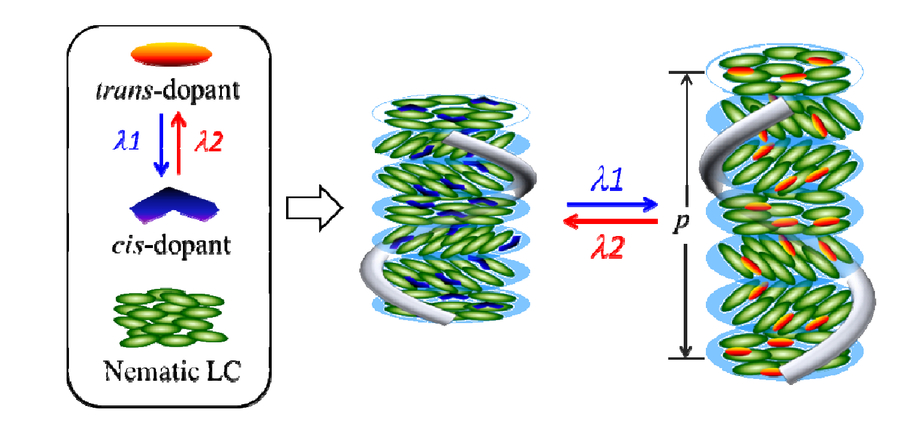 CLCs can be fabricated either by introducing chirality into mesogens forming nematic phase or by the addition of nonracemic chiral dopants to achiral nematic LCs. However, the widely adopted practice has been to add light-driven chiral molecular switches to nematic LC hosts to fabricate dynamic photoresponsive CLCs (Figure 1). The ability of a chiral molecule to impart a twist to a nematic LC is quantified in terms of the helical twisting power (HTP), β, which is expressed by the equation β = 1/(Pc), where c is the molar concentration of the chiral molecular switch. Photoisomerization of the chiral molecular switches results in changes in their molecular conformation and HTP, which consequently lead to a change in the pitch length or handedness of the photoresponsive CLC. It is of paramount importance to design and synthesize photoresponsive chiral molecular switches with high HTP values that display large differences in HTP in their different isomeric states. High HTP values reduce the required concentrations of the dopants to induce CLCs without significantly affecting the optimized properties of the host whereas large differences in HTP of the dopants in different isomeric states enable wide range pitch tunability of the photoresponsive CLCs. In this brief report, we present the research advancements by our lab in the design and synthesis of promising photoisomerizable chiral molecular switches possessing exceptionally high HTPs and exhibiting large variations in their HTP in different isomeric states. We focus here on the commonly employed azobenzene-, dithienylcyclopentene-based light-driven chiral molecular switches (Scheme 1) for the induction and manipulation of photoresponsive CLCs (1D photonic crystal) and LC blue phase systems. It is to be that LC blue phases, i.e. self-organized 3D periodic cubic lattices, have been recognized as soft dynamic 3D photonic crystals.13 Photoresponsive cholesteric microshells and microdroplets fabricated by microfluidic technique have been demonstrated as omnidirectional lasers and reflectors respectively. 2Visible and Near infrared light directing Cholesteric liquid crystalsAzobenzene-based molecular switches possess the unique feature of reversible trans–cis isomerization upon light irradiation, which causes large intramolecular conformational and polarization changes. The trans form of azobenzene has a rod-like structure that is compatible with the LC superstructure, whereas its cis form has a bent structure and generally destabilizes the LC superstructure. As a result of the dramatic difference in molecular geometry of the trans and cis forms, the HTPs of these geometric isomers are dramatically different, which in turn enables optical tuning of the cholesteric pitch and hence the PBG. Generally in a CLC mixture containing a chiral azobenzene, the HTP of these molecular switches depend on their molecular structure, the nature of chirality, and the intermolecular interaction with host LC molecules. A large number of azobenzene based chiral molecular switches have been reported in the literature which undergo trans-cis photoisomerization upon irradiation with UV light. However owing to the inherent disadvantages of UV light, it is highly desirable to develop azobenzene-based chiral molecular switches that can undergo trans-cis isomerization by visible-light irradiation. We hypothesized that by extending the π-conjugation of the aromatic groups linked to the azobenzene moiety, it may be possible to cause trans-cis isomerization by visible light. Keeping this in mind, we designed two enantiomeric azo molecular switches 1 with axial chirality (Scheme 1).14 It was indeed found that these compounds with extended π-conjugation undergo reversible trans-cis photoisomerization only upon visible-light irradiation. These chiral switches were able to induce an optically tunable helical superstructure in nematic LCs. Moreover, reversible dynamicred, green and blue (RGB) reflections were achieved from the CLC mixtures by using only visible light irradiation (Figure 2). After the successful demonstration of pitch modulations of CLCs by UV and visible-light irradiation, we explored the possibility of reflection tuning by near infrared (NIR) irradiation. The idea is to exploit the obvious advantages (superior penetration, less photodamage of materials etc) of NIR light over UV and visible light. Thus, we turned our attention to upconversion nanoparticles (UCNPs), which are known to absorb NIR irradiation and emit UV and visible light. We synthesized a new axially chiral azo molecular switch 2 (Scheme 1) whose UV and visible absorptions significantly overlap with the emission of the NaGdF4 UCNP. This molecular switch and the core-shell UCNPs were mixed with an achiral nematic LC host.15 The resulting nanoparticles-impregnated CLC was found to exhibit reversible NIR-light-guided tunable behavior by simply modulation of the excitation power density of a NIR laser (980 nm). Upon irradiation by the NIR laser at high power density, the reflection wavelength of the photonic superstructure red-shifted, whereas the reverse process occurred upon irradiation with lower power density (Figure 3). Furthermore reversible NIR light directed dynamic RGB reflections has been demonstrated in a single thin film just by varying the power density of the NIR-laser. 3Light directing cholesteric microshells and microdropletsUsually CLCs are investigated in planar geometries for both fundamental scientific studies as well as for device applications. Recently, the unusual and unique phenomena and properties arising from aplanar geometry such as in droplets and microshells have been explored. These studies suggest that the impact and scope of LC applicability could be greatly enhanced by confining them into spherical geometries instead of the traditional thin films. Moreover confinement can lead to appealing configurations within the droplet that reflects a fine balance between interfacial and elastic contributions to the free energy. Thanks to the recent development of microfluidic technique, the facile fabrication of stable three dimensional (3D) droplets and microshells of CLCs with controllable size and shell thickness has been made possible. Promisingly, the microfluidic technique has enabled to overcome the size-polydispersity bottleneck in the fabrication of LC droplets. We recently synthesized the axially chiral molecular switch 3 (Scheme 1), which apparently undergoes green-light-laser induced trans-cis photoisomerization.16 By doping 3 into a commercially available nematic LC we fabricated a visible-light-responsive CLC mixture. This mixture was subsequently used for the fabrication of 3D monodisperse cholesteric microshells by microfludic technique. The micro-shell droplets were water-oil-water double emulsions, in which the oil phase consisted of the photoresponsive CLC with radial orientation of its helical axes. The aqueous phase is 10% polyvinyl alcohol solution which imposed planar orientation of the LC molecules both at the outer and inner interfaces. We demonstrated omnidirectional laser emission from the photoresponsive cholesteric microshells with radial orientation of the helical axes within the shells by laser irradiation. The pumping laser light not only excited the laser dye but also concomitantly tuned the laser emission wavelength. Thus, upon repeated pumping, a red shift in the lasing peak wavelength was induced by photoisomerization of the chiral switch and the consequent shift in the PBG of the cholesteric microshells (Figure 4) Figure 4CLC micro-shells, their POM and confocal microscopy images and light-driven tuning of the lasing wavelength. 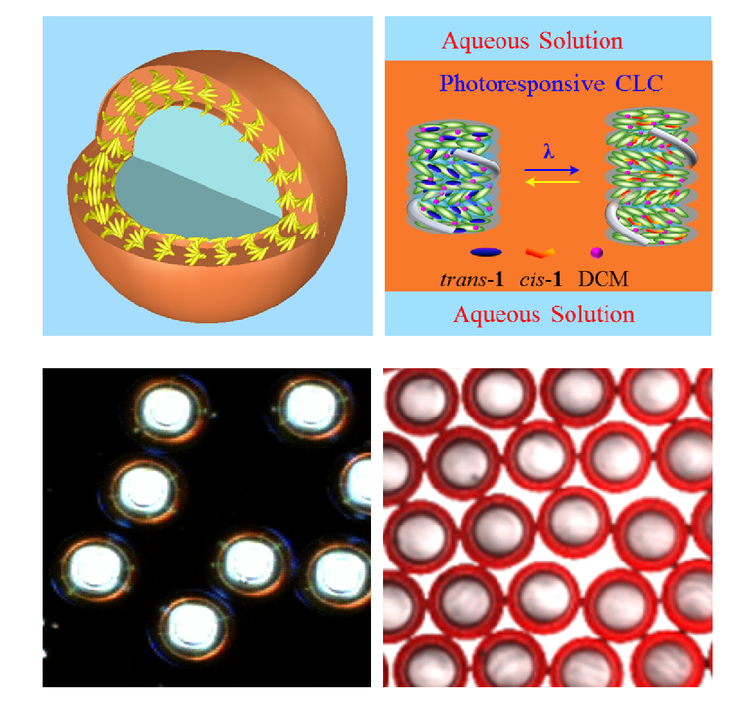 Among photochromic compounds, dithienylcyclopentenes are particularly fascinating because of their superior thermal stability and excellent fatigue resistance. Upon irradiation with UV light, they can transform from a colorless open-ring form to a colored closed-ring form. The reverse process cannot be achieved thermally and occurs only by visible-light irradiation. Since the physical and chemical properties of the two forms are different, the optically reversible switching has been the basis for the creation of new functional and intelligent materials. Compared with chiral azobenzene switches, dithienylcyclopentenes possess the advantage of thermal irreversibility in both the open- and close-ring isomeric states. However, only a few derivatives of dithienylcyclopentenes have been reported as chiral switches capable of inducing photoresponsive CLCs. Moreover, the reported chiral dithienylcyclopentenes exhibited low to moderate HTPs. These relatively low HTPs give rise to the requirement of higher doping concentrations, which often leads to phase separation and coloration etc. Therefore, it is of great practical interest to develop chiral dithienylcyclopentenes with high HTPs. Keeping this in view, we initiated a research program to design and synthesize novel dithienylcyclopentene-based chiral molecular switches with high HTPs. Among the synthesized dithienylcyclopentene-based chiral molecular switches, compound 4 with axial chirality and high HTP was used to fabricate monodisperse cholesteric microdroplets by microfluidic technique.17,18 The microdroplets were dispersed in an aqueous solution of 10% polyvinyl alcohol which resulted radial disposition of the cholesteric axes within the droplet. These 3D droplets exhibited interesting omnidirectional circularly polarized reflections. Moreover they displayed photonic cross communications with neighboring droplets (Figure 5). Since the chiral dopant is stable with respect to temperature, red, green and blue patterns could be obtained by selectively irradiating the microdroplets. Thus photoirradiation of the droplets furnishes dynamic reflection colors without thermal relaxation, whose wavelength can be tuned reversibly by variation of the irradiation time. The monodisperse LC droplets and their colloidal arrays may find application in photonic devices where generation and exploitation of circularly polarized light with tunable wavelength is desired. 4Light directing cholesteric blue phaseRecently, LC blue phases (BPs) that self-organize into a 3D periodic cubic lattice have been recognized as soft self-assembled 3D photonic crystals. It should be noted that BPs exist in highly chiral LCs between the CLC and isotropic phase. If the 3D cubic lattice of the blue phase can be made photoresponsive, then it may be possible to tune the PBG of the blue phase and widen its scope as self-assembled dynamic 3D photonic crystals. Towards this goal, we designed and synthesized the chiral molecular switch 4 (Scheme 1) and fabricated photoresponsive blue phases.19 The resulting blue phases exhibited unprecedented reversible light-induced PBG tuning over the visible region across RGB wavelengths (Figure 6). Such soft self-organized 3D photonic crystals could provide an exciting impetus for the development of all-optical device applications. Very recently we have used the chiral molecular switch 5 (Scheme 1) to fabricate a photoresponsive CLC. An optically tunable beam steering grating has been demonstrated with the CLC finger-print texture.20 It was observed that the significant differences of the HTPs of the isomers of the chiral molecular switch upon photoirradiation is able to shift the diffraction angle of the CLC grating over a very wide range (Figure 7). To the best of our knowledge, this is the LC grating with widest reversible beam steering range reported so far. This wide range non¬mechanical beam steering capability of the CLC has been utilized to demonstrate its potential as a dispersive element for spectrum scanning in spectrometer. Moreover this high tenability light-driven grating with fast and continuous beam steering has great potential in light propagation control and other spectroscopic applications. 5ConclusionsWe have designed and synthesized novel chiral molecular switches with very high HTPs and possessing large difference in HTPs in their isomeric states. These light-driven molecular switches have been used to fabricate photoresponsive CLCs and blue phase. The CLCs and blue phase has been investigated in the context of self-assembled 1D and 3D photonic crystals with phototunable properties. Photoresponsive cholesteric micro-shells and microdroplets have been fabricated by a glass capillary based microfluidic technique. While the micro-shells have been found to exhibit omnidirectional lasing, their microdroplet counterparts display omnidirectional reversibly tunable circularly polarized reflection color. Optically tunable wide range beam steering has been demonstrated with photoresponsive CLCs which could find potential application in light propagation control and spectroscopy. This research summary is expected to spark innovative ideas leading toward the design and engineering of new chiral molecular switches that may self-organize in predicted ways in order to produce advanced photonic materials that have desirable properties and functions. 6.Acknowledgments :The preparation of this article benefited from the support to Quan Li by the Air Force Office of Scientific Research, the Department of Energy, the Army Research Office, the Department of Defense Multidisciplinary University Research Initiative (MURI), the National Aeronautics and Space Administration, and the National Science Foundation, and Ohio Third Frontier. We thank all the Li’s lab current and former members and his collaborators, whose names can be found in the references, for their significant contributions in this project. ReferencesIntelligent Stimuli Responsive Materials: From Well-Defined Nanostructures to Applications, John Wiley & Sons, New Jersey
(2013). https://doi.org/10.1002/9781118680469 Google Scholar
Nanoscience with Liquid Crystals: From Self-Organized Nanostructures to Applications, Springer, Heidelberg
(2014). https://doi.org/10.1007/978-3-319-04867-3 Google Scholar
Y. Wang and Q. Li,
“Light-driven chiral molecular switches or motors in liquid crystals,”
Adv. Mater., 24 1926
–1945
(2012). https://doi.org/10.1002/adma.201200241 Google Scholar
H.K. Bisoyi and Q. Li,
“Light-directing chiral liquid crystalline nanostructures: from 1D to 3D,”
Acc. Chem. Res., 47 3184
–3195
(2014). https://doi.org/10.1021/ar500249k Google Scholar
S. Pieraccini, S. Masiero, A. Ferrarini, and G. P. Spada,
“Chirality transfer across length-scales in nematic liquid crystals: fundamentals and applications,”
Chem. Soc. Rev., 40 258
–271
(2011). https://doi.org/10.1039/B924962C Google Scholar
R. Eelkema and B. L. Feringa,
“Amplification of chirality in liquid crystals,”
Org. Biomol. Chem., 4 3729
–3745
(2006). https://doi.org/10.1039/b608749c Google Scholar
T. J. White, M. E. McConney, and T. J. Bunning,
“Dynamic color in stimuli-responsive cholesteric liquid crystals,”
J. Mater. Chem., 20 9832
–9847
(2010). https://doi.org/10.1039/c0jm00843e Google Scholar
N. Katsonis, E. Lacaze, and A. Ferrarini,
“Controlling chirality with helix inversion in cholesteric liquid crystals,”
J. Mater. Chem., 22 7088
–7097
(2012). https://doi.org/10.1039/c2jm15962g Google Scholar
N. Tamaoki,
“Cholesteric liquid crystals for color information technology,”
Adv. Mater., 13 1135
–1147
(2001). https://doi.org/10.1002/(ISSN)1521-4095 Google Scholar
M. Mitov,
“Cholesteric liquid crystals with a broad light reflection band,”
Adv. Mater., 24 6260
–6276
(2012). https://doi.org/10.1002/adma.201202913 Google Scholar
R. Eelkema,
“Photo-responsive doped cholesteric liquid crystals,”
Liq. Cryst., 38 1641
–1652
(2011). https://doi.org/10.1080/02678292.2011.600779 Google Scholar
Q. Li, Liquid Crystals Beyond Displays: Chemistry, Physics, and Applications, John Wiley and Sons, New Jersey
(2012). https://doi.org/10.1002/9781118259993 Google Scholar
H. Coles and S. Morris,
“Liquid-crystal lasers,”
Nat. Photonics, 4 676
–685
(2010). https://doi.org/10.1038/nphoton.2010.184 Google Scholar
Y. Wang, A. Urbas, and Q. Li,
“Reversible visible-light tuning of self-organized helical superstructures enabled by unprecedented light-driven axially chiral molecular switches,”
J. Am. Chem. Soc., 134 3342
–3345
(2012). https://doi.org/10.1021/ja211837f Google Scholar
L. Wang, H. Dong, Y. Li, C. Xue, L. -D. Sun, C. -H. Yan, and Q. Li,
“Reversible near-infrared light directed reflection in a self-organized helical superstructure loaded with upconversion nanoparticles,”
J. Am. Chem. Soc., 136 4480
–4483
(2014). https://doi.org/10.1021/ja500933h Google Scholar
L. Chen, Y. Li, J. Fan, H. K. Bisoyi, D. A. Weitz, and Q. Li,
“Photoresponsive monodisperse cholesteric liquid crystalline microshells for tunable omnidirectional lasing enabled by a visible light-driven chiral molecular switch,”
Adv. Opt. Mater., 2 845
–848
(2014). https://doi.org/10.1002/adom.201400166 Google Scholar
J. Fan, Y. Li, H. K. Bisoyi, R. S. Zola, D. Yang, T. J. Bunning, D. A. Weitz, and Q. Li,
“Light-directing omnidirectional circularly polarized reflection from liquid-crystal droplets,”
Angew. Chem. Int. Ed., Google Scholar
Y. Li, C. Xue, M. Wang, A. Urbas, and Q. Li,
“Photodynamic chiral molecular switches with thermal stability: from reflection wavelength tuning to handedness inversion of selforganized helical superstructures,”
Angew. Chem. Int. Ed., 52 13703
–13707
(2013). https://doi.org/10.1002/anie.201306396 Google Scholar
T.-H. Lin, Y. Li, C.-T. Wang, H.-C. Jau, C.-W. Chen, C.-C. Li, H. K. Bisoyi, T. J. Bunning, and Q. Li,
“Red, green and blue reflections enabled in optically tunable selforganized 3D cubic nanostructured thin film,”
Adv. Mater., 25 5050
–5054
(2013). https://doi.org/10.1002/adma.201300798 Google Scholar
H.C. Jau, Y. Li, C. C. Li, C. W. Chen, C. T. Wang, Hari Krishna Bisoyi, T. H. Lin, T. J. Bunning, and Q. Li,
“Light-driven wide-range non-mechanical beam steering and spectrum scanning based on a self-organized liquid crystal grating enabled by a chiral molecular switch,”
Adv. Opt. Mater., Google Scholar
|


